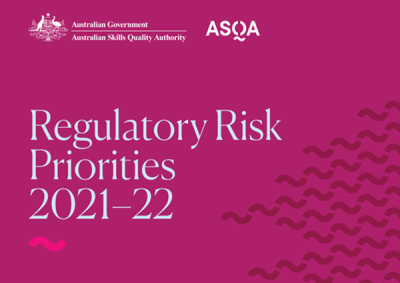- Home
- Regulatory Risk Priorities
Regulatory Risk Priorities
-
Regulatory Risk Priorities 2024-2510 Jul 2024
Today, we have published our Regulatory Risk Priorities for 2024-25. We identify our Regulatory Risk Priorities through environmental scans and sector research, issues raised by students and other stakeholders, and internal data collection and analysis.
-
ASQA’s planned program of work supports confidence in the quality and integrity of national VET26 Aug 2022
The Australian Skills Quality Authority (ASQA) today released its Regulatory Risk Priorities for 2022-23.
-
ASQA’s Regulatory Risk Priorities for 2021–2222 Oct 2021
Today we released our Regulatory Risk Priorities for 2021–22, outlining our regulatory risk priorities for the next year. We update these priorities regularly to ensure we are responding to the most current issues in the sector.
-
Risk priorities
ASQA outlines regulatory risk priorities regularly to ensure we are responding to the most current issues in the sector.
-
Setting our risk priorities
We use a risk-based approach to determine the most significant risks to achieving ASQA’s purpose, which is to ensure quality VET and the integrity of national qualifications issued by training providers.
-
Academic integrity
We will not tolerate provider behaviours that are complicit in enabling academic cheating or exploiting the vulnerabilities of student particular cohorts.
-
Student work placement
We are focusing on provider behaviours that maximise student enrolment numbers without considering placement availability and their capacity to support students.
-
Online delivery
Our regulatory activity is focusing on those providers that deliver online courses that are not suited to this mode of delivery, that offer insufficient support to online students or where online delivery does not meet quality or quantity standards.
-
Shortened course duration
We are focussed on providers that prioritise cost efficiency over training quality and student outcomes by reducing volume of learning or shortening training delivery timeframes, particularly in higher risk occupations.
-
Recognition of prior learning
We have a low tolerance of inadequate assessment practices and business models that are cutting corners in issuing RPL.
Share









